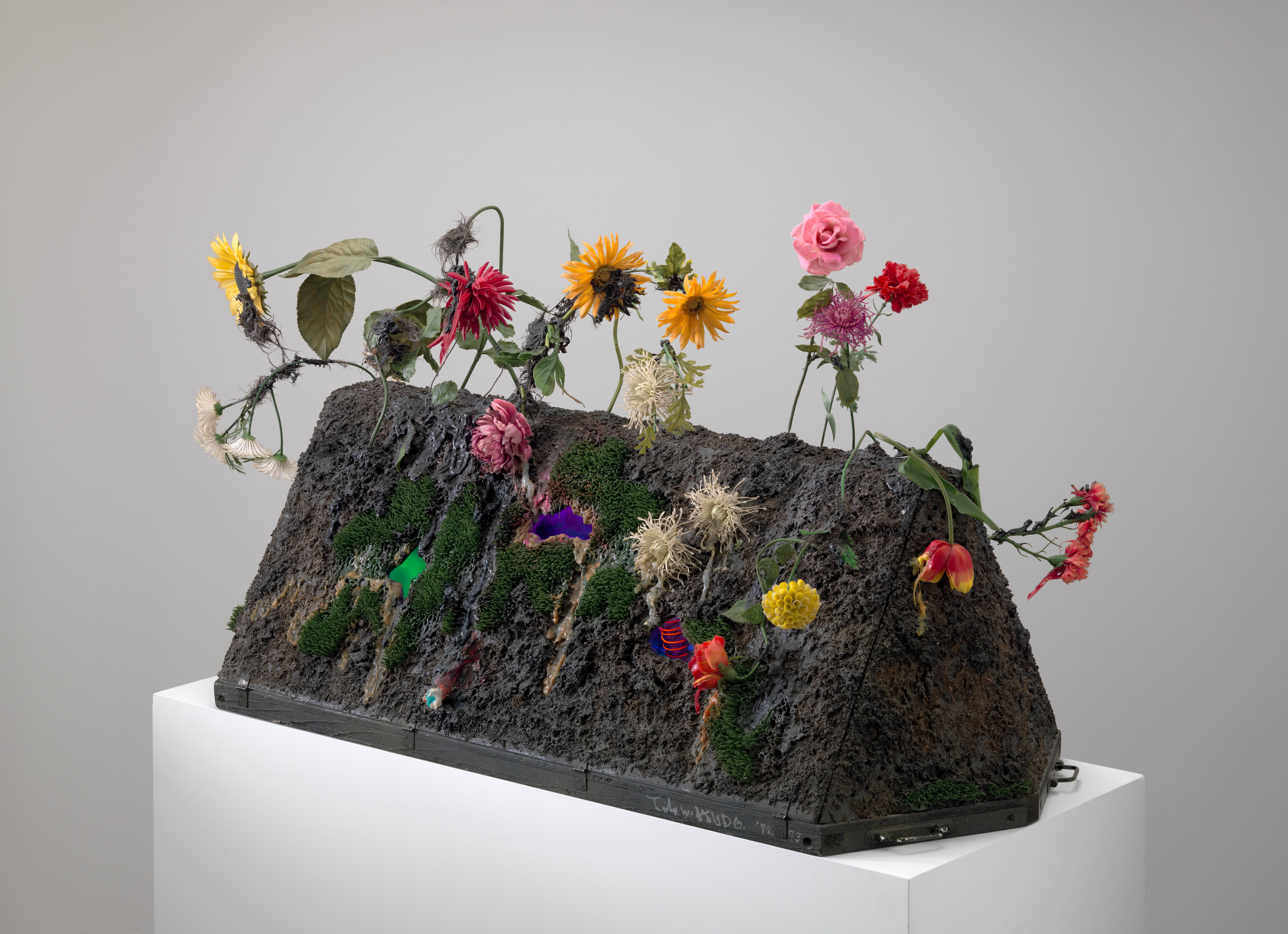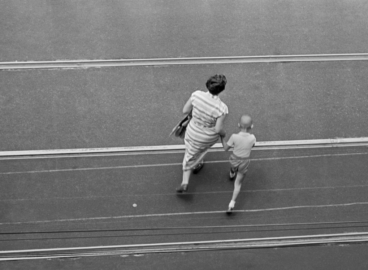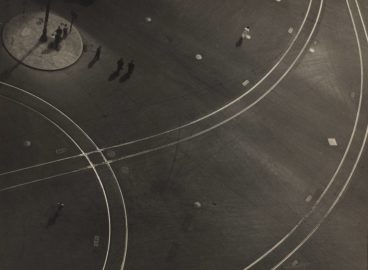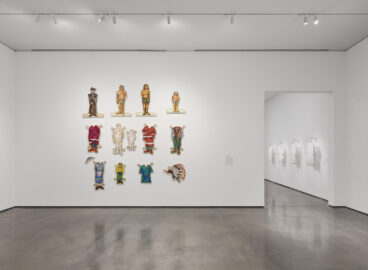Carlito Carvalhosa, who died in May at the age of 59, was one of the most widely praised contemporary figures in Brazilian art. In this homage to the late artist, Luis Pérez-Oramas reflects on their collaboration for the 2011 exhibition at the Museum of Modern Art, Carlito Carvalhosa: Sum of Days.
Este artículo está disponible en español.
Este artigo está disponível em portugues.
In 2011, in my role as curator, I had the privilege of assisting Carlito Carvalhosa (1961–2021) with the installation of his work Sum of Days in the Donald B. and Catherine C. Marron Family Atrium of The Museum of Modern Art,1Sum of Days, a performative installation by Carlito Carvalhosa, was on exhibit at MoMA between August 24 and November 14, 2011. The exhibition was organized by Luis Pérez-Oramas, The Estrellita Brodsky Curator of Latin American Art, and Geaninne Gutiérrez-Guimarães, Curatorial Assistant. A prior incarnation of the work—A soma dos dias—was exhibited in 2010 in the octagonal atrium of the Pinacoteca do Estado de São Paulo, the programming for which was organized by Ivo Mesquita. a space devoted to large installations and performances that was conceived by Yoshio Taniguchi as part of the extension of MoMA in 2004.
Carlito Carvalhosa passed away on May 13, 2021.
Born in São Paulo, Carvalhosa lived most of his life in Rio de Janeiro, where he embraced the radical legacy of several generations of artists from Rio who preceded him. He brought their achievements to new, unprecedented dimensions in terms of concept, form, and scale.
This assertion is all the more significant since the radical weight of some of those predecessors’ propositions was carried by the generations that followed them as a conclusive “no way out” in terms of art practice. Such is the case of artists like Hélio Oiticica and Lygia Clark, whose late works, ephemeral and anti-monumental, clearly stepped on territories that transcended the conventional frames of art, toward the extended fields of the beyond-art: therapy or social practice, quasi-cinema and anti-art.
By 1980, young artists working in Brazil therefore had to embrace this exhausting legacy while inventing ways to keep their own practices alive: they had to welcome it as a humbling lesson, and at the same time, were confronted by the necessity of forging new paths of their own; they had to accept the legacy of their predecessors while re-inscribing their own practices back into the historical conventions of visual art.
Only from this perspective can one grasp that, for instance, the abundance of painting surfacing in Brazil by the mid-1980s was much more than, and certainly more significant than, simply another purely fashionable return to painting.2In the 1980s, Carlito Carvalhosa founded, alongside artists Nuno Ramos, Fábio Miguez, Rodrigo Andrade, and Paulo Monteiro, the Brazilian group Casa 7, which embraced avant-garde painterly investigations.
Neo-Concretism’s Theory of the Nonobject, Oiticica’s General Scheme of the New Objectivity, Clark’s Phantasmatic of the Body, and Antonio Manuel’s Body/Work3On Ferreira Gullar’s influential essay titled Theory of the Nonobject (1960), a tacit manifesto for the Neo-Concretist movement, see: Mónica Amor, Theories of the Nonobject: Argentina, Brazil, Venezuela 1944–1969 (Oakland: University of California Press, 2016). In the following years artists produced equally landmark texts, such as Hélio Oiticica’s “General Scheme of the New Objectivity” (1967) or Lygia Clark’s “Phantasmatic of the Body” (1974). All these radical propositions were accompanied by actions, performances, and art works that aligned with their radical positions, such as the Performance/Manifesto Corpobra with which Antonio Manuel submitted his body as a work of art to the National Salon at the Museum of Modern Art, Rio de Janeiro in 1970. were milestones of aesthetic newness as well as experiences of art exhaustion, historically and formally, predating manifestations such as relational aesthetics and post-subjective performative art. The equation to solve was, likely, what the afterlife of painting (and of art for that matter) could be following the invention of typologies such as Parangolé (Oiticica), Obra mole (Soft Work) (Clark), or Objeto ativo (Active Object) (Willys de Castro).
The entire repertoire of Carlito Carvalhosa’s oeuvre responded to this historical challenge, from his inception as a painter embedded in the dark sources of the formless to his striking performative installations using fabric, neon, wood, wax, mirrors, and sound.
It therefore occurred to me, while we were installing Sum of Days at MoMA in 2011, that Carlito’s work implied an unprecedented amplification of the category tokened by Lygia Clark as Obra mole.
This was not only, for Clark, a way to question the solid certainty of sculpture by using malleable rubber and by posing, literally, sculptures on the arms and over the body of the beholder, it was also a natural continuity of her quest for a spatial form that would not be determined by notions such as inner and outer, center and periphery, top and base, etc. In her journey looking for this permanently fluid form of sculpture, what mattered was the idea, and the experience, of emergence.
Irene Small has written, while considering Oiticica’s “soft” and performative works known as Parangolés, that they condense “the organism’s capacity for change into its material structure, resulting in a composite body in continuous flux but with no stable shape. Such a body can no longer be assessed in a single ideal state. Rather, the Parangolé embodies emergence in its very form.”4Irene V. Small, Hélio Oiticica: Folding the Frame (Chicago: University of Chicago Press, 2016), 216. Emphasis original.
One can easily apply such a description to Carvalhosa’s Sum of Days, an immense, architectural, scenic Parangolé that set a performative dimension for space itself. Between an overwhelming Parangolé and a gigantic Obra mole, Carvalhosa’s installation consisted of a spiral-shaped labyrinth made of white fabric hanging from the ceiling of MoMA’s atrium, lighted by vertical lines of neon attached to the walls, radiantly filling the abyss of that architectural hole. One might bring to this description, also from Clark’s theoretical repertoire, the notion of empty/fullness as being potentiated by Carvalhosa to a point that it materializes a monumental fragility embodying the space we inhabit.
But Sum of Days was not only a towering feature bringing sculpture’s softness and the void of the full to a not-yet-seen milestone, it was also a sonic experience, an immensely complex and subtle one, implying the participation of Carvalhosa’s friend Philip Glass and his ensemble, whose scheduled performances inside the impeccable labyrinth of the work were systematically recorded, as were the audience’s noises and voices made while inhabiting the structure.
For that matter, Carvalhosa conceived a sophisticated recording system with elongated cords and microphones also hanging from the ceiling and attached to the surrounding walls, melancholically drawing against the whiteness of the space their lines as enigmatic graphic presences. Throughout the duration of the show, these recordings of sound and noise—sounds of music and music of sounds—were played back into the work, producing a constant, lofty layering of illegible and haunting densities of sonic presence.
The work functioned like a physical tautology: there was indeed the sum of days emerging, incrementally, through an accumulative temporality, a time that was not sequential anymore but made present as a mass, in the uncanny slickness of sound layering, occupying as seemingly immaterial as it was invisible the spiral of white draperies cascading from the atrium’s ceiling.
One has to consider this exceptional feat: Carlito Carvalhosa’s Sum of Days is an installation—sculptural, architectural, sonic and performative—that is capable of transforming—translating, transfiguring—the sequentially driven course of time into a spatial simultaneity. As such, the secular and binary distinction between spatial, simultaneous forms of art and sequential arts of time, established by Lessing in his Laocoon,5Gotthold Ephraim Lessing, Laocoon: An Essay on the Limits of Painting and Poetry (1766), trans. Edward Allen McCormick (Indianapolis: Bobbs-Merrill, 1962). and revamped by Greenberg in his “Newer Laocoon,”6Clement Greenberg, “Towards a Newer Laocoon,” Partisan Review 7, no. 4 (July–August 1940). happens to be entirely deactivated, dismantled, deconstructed, and ultimately neutralized in our experience of Sum of Days.
Alexandre Kojève’s notion of désoeuvrement, or even Saint Paul’s katergeín,7On the links between these two terms, see Giorgio Agamben, Le temps qui reste. Un commentaire de l’Épître aux Romains (Paris: Payot and Rivages, 2000). are rather more adept terms for this achievement because, by propelling to a new level the consequences of radical Brazilian categories such as Parangolé or Obra mole, Carlito Carvalhosa’s masterwork signaled the overcoming of a formal regulation that had dominated Western visual arts for centuries. Sum of Days is an enormous, fluid, porous, and fragile form that contains its space rather than being contained by it, a sculpture of sound that materializes as emergence, a sculpture of time. Consequently, the deactivation of sequential and spatial art polarities implied by Sum of Days makes possible a landmark achievement sought by artists and philosophers, poets and fablers, since unimaginable bygone days of art: temporality shaping itself as space, space emerging as time, elliptical, returning, surging.
Suspension (literally) and occupation through sculptures and installations, opaque material densities and reflexing surfaces (also literally), were the simple keys of a work that unfolded from Carlito Carvalhosa’s restless artistic practice—in the form of three-dimensional paintings and countless sculptural achievements—for forty years, since the early 1980s until his untimely death. I was lucky enough to have known him, to have continued my exchanges with him up to his last days on Earth.
Mourning his passing, I keep thinking of the vast history of draperies; of ancient, glorious winged victories; of wandering pagan Nymphs wrapped in their habits and morphed by the wind; of Dionysian rhythms of samba in the heights of Rio’s hills that break in rapture among dancing Parangolés.
Ceaseless transfiguration and dérive of forms are the endless matters of art history. But it only falls on few, touched by the duende or lifted by the angel—as Lorca would say—to embody the fullness of their potentiality. Carlito Carvalhosa was one of them and his work will overcome his passing, time and again, casting on us the unfinished enlightenment of its dromenon.
All images are installation views of the exhibition Carlito Carvalhosa: Sum of Days unless otherwise noted.
- 1Sum of Days, a performative installation by Carlito Carvalhosa, was on exhibit at MoMA between August 24 and November 14, 2011. The exhibition was organized by Luis Pérez-Oramas, The Estrellita Brodsky Curator of Latin American Art, and Geaninne Gutiérrez-Guimarães, Curatorial Assistant. A prior incarnation of the work—A soma dos dias—was exhibited in 2010 in the octagonal atrium of the Pinacoteca do Estado de São Paulo, the programming for which was organized by Ivo Mesquita.
- 2In the 1980s, Carlito Carvalhosa founded, alongside artists Nuno Ramos, Fábio Miguez, Rodrigo Andrade, and Paulo Monteiro, the Brazilian group Casa 7, which embraced avant-garde painterly investigations.
- 3On Ferreira Gullar’s influential essay titled Theory of the Nonobject (1960), a tacit manifesto for the Neo-Concretist movement, see: Mónica Amor, Theories of the Nonobject: Argentina, Brazil, Venezuela 1944–1969 (Oakland: University of California Press, 2016). In the following years artists produced equally landmark texts, such as Hélio Oiticica’s “General Scheme of the New Objectivity” (1967) or Lygia Clark’s “Phantasmatic of the Body” (1974). All these radical propositions were accompanied by actions, performances, and art works that aligned with their radical positions, such as the Performance/Manifesto Corpobra with which Antonio Manuel submitted his body as a work of art to the National Salon at the Museum of Modern Art, Rio de Janeiro in 1970.
- 4Irene V. Small, Hélio Oiticica: Folding the Frame (Chicago: University of Chicago Press, 2016), 216. Emphasis original.
- 5Gotthold Ephraim Lessing, Laocoon: An Essay on the Limits of Painting and Poetry (1766), trans. Edward Allen McCormick (Indianapolis: Bobbs-Merrill, 1962).
- 6Clement Greenberg, “Towards a Newer Laocoon,” Partisan Review 7, no. 4 (July–August 1940).
- 7On the links between these two terms, see Giorgio Agamben, Le temps qui reste. Un commentaire de l’Épître aux Romains (Paris: Payot and Rivages, 2000).













